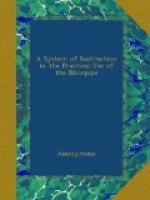18. Silver Foil.—A small piece of silver foil is used for the purpose of detecting sulphur and the sulphides of the metals, which impart a dark stain to it. If no silver foil is at hand, strips of filtering paper, impregnated with acetate of lead, will answer in many cases.
19. Nitroprusside of Sodium (Fe^{2}Cy^{5}, NO^{5}, 2Na).—This is a very delicate test for sulphur, and was discovered by Dr. Playfair. This test has lately been examined with considerable ability by Prof. J.W. Bailey, of West Point. If any sulphate or sulphide is heated by the blowpipe upon charcoal with the carbonate of soda, and the fused mass is placed on a watch-glass, with a little water, and a small piece of the nitroprusside of sodium is added, there will be produced a splendid purple color. This color, or reaction, will be produced from any substance containing sulphur, such as the parings of the nails, hair, albumen, etc. In regard to these latter substances, the carbonate of soda should be mixed with a little starch, which will prevent the loss of any of the sulphur by oxidation. Coil a piece of hair around a platinum wire, moisten it, and dip it into a mixture of carbonate of soda, to which a little starch has been added, and then heat it with the blowpipe, when the fused mass will give with the nitroprusside of sodium the characteristic purple reaction, indicative of the presence of sulphur. With the proper delicacy of manipulation, a piece of hair, half an inch in length, will give distinct indications of sulphur.
Preparation.—The nitroprussides of sodium and potassium (for either salt will give the above reactions), are prepared as follows: One atom (422 grains) of pulverized ferrocyanide of potassium is mixed with five atoms of commercial nitric acid, diluted with an equal quantity of water. One-fifth of this quantity (one atom) of the acid is sufficient to transfer the ferrocyanide into nitroprusside; but the use of a larger quantity is found to give the best results. The acid is poured all at once upon the ferrocyanide, the cold produced by the mixing being sufficient to moderate the action. The mixture first assumes a milky appearance, but after a little while, the salt dissolves, forming a coffee-colored solution, and gases are disengaged in abundance. When the salt is completely dissolved, the solution is found to contain ferrocyanide (red prussiate) of potassium, mixed with nitroprusside and nitrate of the same base. It is then immediately decanted into a large flask, and heated over the water-bath. It continues to evolve gas, and after awhile, no longer yields a dark blue precipitate with ferrous salts, but a dark green or slate-colored precipitate. It is then removed from the fire, and left to crystallize, whereupon it yields a large quantity of crystals of nitre, and more or less oxamide. The strongly-colored mother liquid is then neutralized with carbonate of potash or soda, according to the salt to be prepared, and the solution is boiled, whereupon it generally deposits a green or brown precipitate, which must be separated by filtration. The liquid then contains nothing but nitroprusside and nitrate of potash or soda. The nitrates being the least soluble, are first crystallized, and the remaining liquid, on farther evaporation, yields crystals of the nitroprusside. The sodium salt crystallizes most easily.—(PLAYFAIR.)




